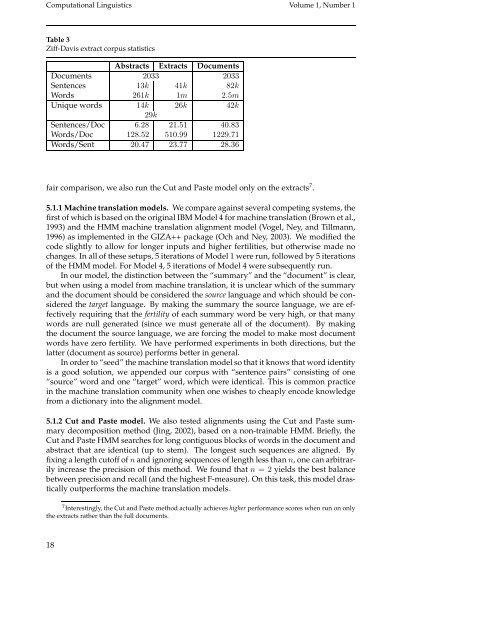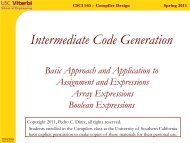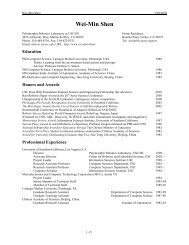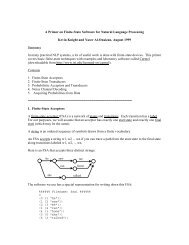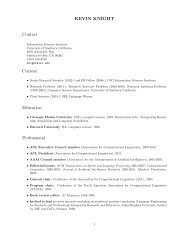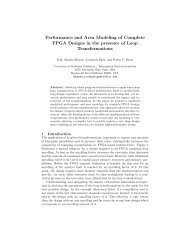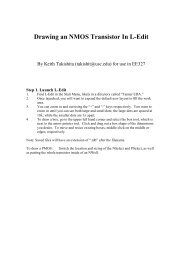Induction of Word and Phrase Alignments for Automatic Document ...
Induction of Word and Phrase Alignments for Automatic Document ...
Induction of Word and Phrase Alignments for Automatic Document ...
You also want an ePaper? Increase the reach of your titles
YUMPU automatically turns print PDFs into web optimized ePapers that Google loves.
Computational Linguistics Volume 1, Number 1<br />
Table 3<br />
Ziff-Davis extract corpus statistics<br />
Abstracts Extracts <strong>Document</strong>s<br />
<strong>Document</strong>s 2033 2033<br />
Sentences 13k 41k 82k<br />
<strong>Word</strong>s 261k 1m 2.5m<br />
Unique words 14k 26k 42k<br />
29k<br />
Sentences/Doc 6.28 21.51 40.83<br />
<strong>Word</strong>s/Doc 128.52 510.99 1229.71<br />
<strong>Word</strong>s/Sent 20.47 23.77 28.36<br />
fair comparison, we also run the Cut <strong>and</strong> Paste model only on the extracts 7 .<br />
5.1.1 Machine translation models. We compare against several competing systems, the<br />
first <strong>of</strong> which is based on the original IBM Model 4 <strong>for</strong> machine translation (Brown et al.,<br />
1993) <strong>and</strong> the HMM machine translation alignment model (Vogel, Ney, <strong>and</strong> Tillmann,<br />
1996) as implemented in the GIZA++ package (Och <strong>and</strong> Ney, 2003). We modified the<br />
code slightly to allow <strong>for</strong> longer inputs <strong>and</strong> higher fertilities, but otherwise made no<br />
changes. In all <strong>of</strong> these setups, 5 iterations <strong>of</strong> Model 1 were run, followed by 5 iterations<br />
<strong>of</strong> the HMM model. For Model 4, 5 iterations <strong>of</strong> Model 4 were subsequently run.<br />
In our model, the distinction between the “summary” <strong>and</strong> the “document” is clear,<br />
but when using a model from machine translation, it is unclear which <strong>of</strong> the summary<br />
<strong>and</strong> the document should be considered the source language <strong>and</strong> which should be considered<br />
the target language. By making the summary the source language, we are effectively<br />
requiring that the fertility <strong>of</strong> each summary word be very high, or that many<br />
words are null generated (since we must generate all <strong>of</strong> the document). By making<br />
the document the source language, we are <strong>for</strong>cing the model to make most document<br />
words have zero fertility. We have per<strong>for</strong>med experiments in both directions, but the<br />
latter (document as source) per<strong>for</strong>ms better in general.<br />
In order to “seed” the machine translation model so that it knows that word identity<br />
is a good solution, we appended our corpus with “sentence pairs” consisting <strong>of</strong> one<br />
“source” word <strong>and</strong> one “target” word, which were identical. This is common practice<br />
in the machine translation community when one wishes to cheaply encode knowledge<br />
from a dictionary into the alignment model.<br />
5.1.2 Cut <strong>and</strong> Paste model. We also tested alignments using the Cut <strong>and</strong> Paste summary<br />
decomposition method (Jing, 2002), based on a non-trainable HMM. Briefly, the<br />
Cut <strong>and</strong> Paste HMM searches <strong>for</strong> long contiguous blocks <strong>of</strong> words in the document <strong>and</strong><br />
abstract that are identical (up to stem). The longest such sequences are aligned. By<br />
fixing a length cut<strong>of</strong>f <strong>of</strong> n <strong>and</strong> ignoring sequences <strong>of</strong> length less than n, one can arbitrarily<br />
increase the precision <strong>of</strong> this method. We found that n = 2 yields the best balance<br />
between precision <strong>and</strong> recall (<strong>and</strong> the highest F-measure). On this task, this model drastically<br />
outper<strong>for</strong>ms the machine translation models.<br />
7 Interestingly, the Cut <strong>and</strong> Paste method actually achieves higher per<strong>for</strong>mance scores when run on only<br />
the extracts rather than the full documents.<br />
18


